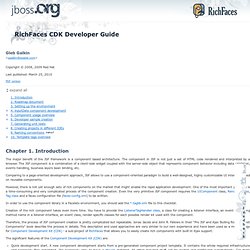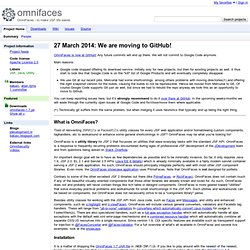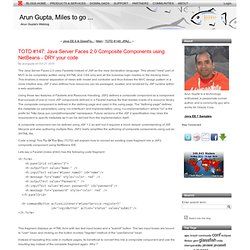

PrimeFaces. PrimeFaces Extensions. JSF Corner. RichFaces CDK Developer Guide. Well, it is almost the final step in the component creation process - component configuration.

Note that you should register all the classes and attributes of the <inputDate> component. If you will create the component dynamically on a page you should register the component in the faces context configuration file - faces-config.xml. If you use a custom tag on a JSP page you need a TLD file for registration. If you plan to use Facelets you need inputDate.taglib.xml descriptor.
The CDK factory uses the inputDate.xml file for generating not only the complete UIInputDate class, but also a JSP Tag Handler, faces-config.xml and descriptors for JSP and Facelets. Please, proceed to the src/main/config/component directory, open the inputDate.xml in your favorite text editor and take a look at the skeleton: there is a root element <components> with the one nested <component> element.
Tip: It is possible to create a number of components in the one project. The UIInputDate class ... Example: ... ... ... Omnifaces - OmniFaces - to make JSF life easier. OmniFaces is now at GitHub!

Any future commits will end up there. We will not commit to Google Code anymore. Main reasons: Google code stopped offering its download service. Initially only for new projects, but then for existing projects as well. You can keep reporting issues here, but it's strongly recommend to do it over there at GitHub. (+) Technically git suffers from the same problem, but when merging it uses heuristics that typically end up being the right thing. Tired of reinventing JSFUtils or FacesUtils utility classes for every JSF web application and/or homebrewing custom components, taghandlers, etc to workaround or enhance some general shortcomings in JSF? OmniFaces is a utility library for JSF 2 that focusses on utilities that ease everyday tasks with the standard JSF API. An important design goal will be to have as few dependencies as possible and to be minimally invasive.
Installation It is a matter of dropping the OmniFaces 1.7 JAR file in /WEB-INF/lib. Xmlns:o=" Demo. Examples-arquillian at master from jsfunit/jsfunit - GitHub. JSF Tag Reference. Arun Gupta, Miles to go ...: TOTD #147: Java Server Faces 2.0 Composite Components using NetBeans - DRY your code. The Java Server Faces 2.0 uses Facelets instead of JSP as the view declaration language.

This allows "view" part of MVC to be completely written using XHTML and CSS only and all the business logic resides in the backing bean. This enables a cleaner separation of views with model and controller and thus follows the MVC design pattern in a more intuitive way. JSF 2 also defines how resources can be packaged, located, and rendered by JSF runtime within a web application. Using these two features of Facelets and Resource Handling, JSF2 defines a composite component as a component that consists of one or more JSF components defined in a Facelet markup file that resides inside of a resource library. The composite component is defined in the defining page and used in the using page. A composite component can be defined using JSF 1.2 as well but it requires a much deeper understanding of JSF lifecycle and also authoring multiple files.
Code is king! And click on "Finish". xmlns:ez="